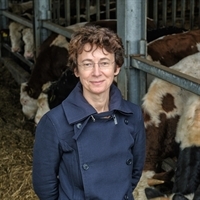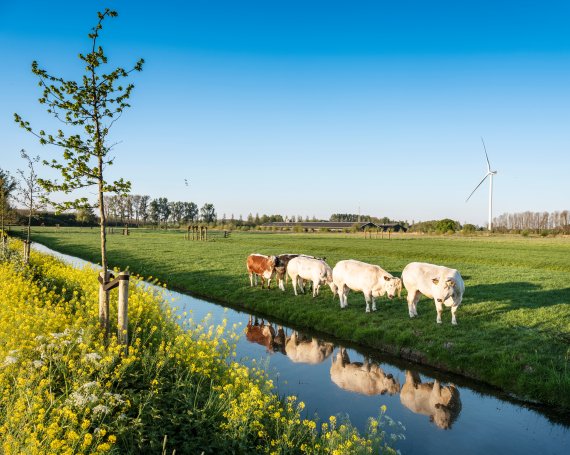The Dutch cabinet lacks the ambition needed to deal with the country’s nitrogen problem, said the Remkes commission early this month. Just as WUR published a roadmap for reducing the nitrogen load around nature areas.
The Remkes Commission’s final report has sparked renewed political debate about nitrogen emissions in the Netherlands. At the press conference of 8 June, Remkes criticized the current cabinet’s policy, which aims at a 26 per cent reduction in nitrogen by 2030. The advisory commission does not think that is ambitious enough and proposes a goal of 50 per cent less nitrogen by 2030. Such a reduction is feasible if the proposals coming from the agricultural sector are implemented in the next few years, claims Remkes. He also says there are too few legal safeguards and too much room for manoeuvre in the cabinet’s plans for them to achieve their goals for nature.
Firm
The left-wing opposition and nature organizations applauded Remkes’ firm language, while the agriculture sector was disappointed. The report will play a role when the Lower House debates Minister Schouten’s proposed nitrogen policy later this year.
Transition
In the meantime, the cabinet and the Remkes Commission are agreed on the urgency of solving the nitrogen problem. ‘We’ve got to make the transition to low-emissions agriculture,’ says Remkes. ‘That calls for measures that target areas specifically. It is up to the provinces to come up with the specifics.’ An extensive monitoring network around nature areas is proposed, to clarify which livestock farms are causing the most damage and should therefore either be closed down or adapted to use low-emissions farming methods.’

Spatial approach
Two days before Remkes presented his report, WUR’s Nitrogen Taskforce published a five-stage roadmap to set this process in motion. The timing was surely no coincidence? ‘Not entirely,’ says Tia Hermans, chair of the Taskforce. ‘It was known well in advance when Remkes would present his recommendations. We took advantage of that momentum.’ The staged plan, intended for the provincial governments, describes how agriculture and nature can move together towards reducing nitrogen deposition and improving the quality of nature areas. ‘It is a spatial planning approach, in which we introduce both national and local measures in a conversation specific to an area,’ says Hermans.
The roadmap shows how government can have the most impact within the available budget
Stages
The plan sets out five stages in the process. The first stage is identifying the nature areas that suffer from excessive nitrogen and the reduction in nitrogen deposition needed in each area. The second stage involves calculating the effects of generic agricultural measures planned by the ministry of Agriculture, Nature and Food on the nitrogen deposition in a given nature area. For example: how do low-emission barns and feed-related measures contribute to lower nitrogen depositions? The third stage is an assessment of the quality of the nature in the area and the potential impact of nature restoration measures. WUR takes a broader perspective on this than just looking at nitrogen deposited from the air. Hermans: ‘Nature is also affected by dryness, fertilizers, acidification and fragmentation of the landscape.’
From local to national
The analyses provide results at the area level, so provinces can talk to farmers’ organizations, nature organizations and water boards about additional local measures to take to achieve the nature-related goals. So the fourth stage targets area-specific measures for farming and nature. An example would be livestock farmers whose farms are close to nature areas. If these local measures prove not to benefit the nature areas sufficiently, the process continues into the fifth stage, asking: what additional national measures are called for?
Buying up
‘This plan is based on policy considerations,’ explains Hermans. At the fourth stage, you could consider buying up livestock farms around nature areas, or you could install low-emissions measures on those farms. Another option, if you want to clear up the blanket of nitrogen covering the Netherlands, would be to close down polluting farms at stage 2. ‘The roadmap shows how government can have the most impact within the available budget.’
Hermans describes the plan as a method for getting a clear picture of the nitrogen problem in an area, and for finding solutions together with stakeholders. ‘It is important for nature managers and farmers to get to grips with the task at hand regarding nitrogen.’ She is not afraid that farmers’ protests will queer the pitch. ‘A lot of farmers set great store by nature and really want to find options for low-emission farming. Their biggest need is to see signs of hope on the horizon.’
Drastic
The Remkes Commission gave them that hope on the horizon: halving nitrogen emissions by 2030. That is an ambitious goal, which is fine, says Jan Dijkstra, livestock feed expert and a member of the Wageningen Taskforce. But he doubts whether Remkes’s ambitions are feasible. ‘Halving emissions is theoretically possible, but it does require drastic measures, like adapted barns. And that is a very costly business.’ The same goes for the commission’s recommendation to ban slurry. ‘For many farmers, that requires a completely new barn design. That is a tall order if you have just invested in a new low-emission barn.’ Dijkstra sees it as a positive point that Remkes emphasizes goals rather than means. ‘That give farmers scope for their professional know-how, and for customized approaches.’
| Collaborating in the Nitrogen Taskforce |
|---|
| Finding solutions together takes time. This is reflected in the experience of WUR’s Nitrogen Taskforce, which brought Wageningen animal scientists, ecologists, agrotechnologists, economists and spatial planners together to create a roadmap for tackling the nitrogen problem. This kind of collaboration was new to most of the participants, and livestock and nature researchers held in-depth discussions for the first time. Jan Dijkstra, who describes himself as a ‘dyed-in-the-wool animal feeds man’ at WUR, thoroughly enjoyed learning about the ecological aspects of ammonia. ‘One of the things I learned from the ecologists was that nature restoration is not just about nitrogen, but that a high water table in some nature areas can be even more important for achieving nature-related objectives. That’s something livestock farmers in those sorts of areas need to know, so they understand which measures they should take to contribute to nature restoration.’ In turn, ecologist Nina Smits learned when the livestock farmers produce ammonia, and which techniques and management approaches she could use to influence those emissions. ‘During the discussion, animal scientists explained which measures farmers could use to reduce their emissions of x tons of nitrogen, and then they looked at me and asked: what does that mean for nature? And I had to disappoint them. I can’t say what lower emissions will mean for the nitrogen deposition in a particular nature area, because to do that you need more information about the local situation.’ Both Dijkstra and Smits say the nitrogen problem is highly complex and is made up lots of smaller problems. Chair Tia Hermans: ‘For the first time, we have really thought through what one aspect of the problem means for another aspect of it. That is what makes this a genuinely joint Wageningen plan.’ Apart from the people mentioned in this article, others who took part in the taskforce are: Karin Groenestein, Nico Ogink, Jan Huijsmans, Gerard Velthof, Raymond Jongschaap, Peter Geerdink, Sandra Munniks, Roel Jongeneel and Marc Ravesloot. |

 Photo: Shutterstock
Photo: Shutterstock